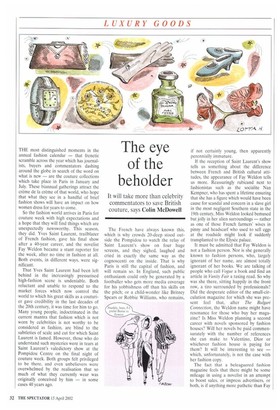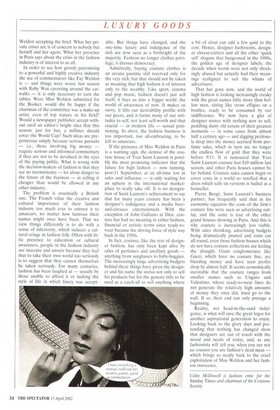The eye of the beholder
It will take more than celebrity commentators to save British couture, says Colin McDowell
THE most distinguished moments in the annual fashion calendar — that frenetic scramble across the year which has journalists, buyers and commentators dashing around the globe in search of the word on what is new — are the couture collections which take place in Paris in January and July. These biannual gatherings attract the creme de la creme of that world, who hope that what they see in a handful of brief fashion shows will have an impact on how women dress for years to come.
So the fashion world arrives in Paris for couture week with high expectations and a hope that they will find things which are unexpectedly newsworthy. This season, they did. Yves Saint Laurent, trailblazer of French fashion, gave his final show after a 40-year career, and the novelist Fay Weldon became a stunt reporter for the week, after no time in fashion at all. Both events, in different ways, were significant.
That Yves Saint Laurent had been left behind in the increasingly pressurised high-fashion scene is undeniable. Both reluctant and unable to respond to the market forces which now control the world to which his great skills as a couturier gave credibility in the last decades of the 20th century, it was time for him to go. Many young people, indoctrinated in the current mantra that fashion which is not worn by celebrities is not worthy to be considered as fashion, are blind to the subtleties of scale and cut for which Saint Laurent is famed. However, those who do understand such mysteries were in tears at Saint Laurent's valedictory show at the Pompidou Centre on the final night of couture week. Both groups felt privileged to be there, and even unbelievers were overwhelmed by the realisation that so much of what they currently wear was originally conceived by him — in some cases 40 years ago. The French have always known this, which is why crowds 20-deep stood outside the Pompidou to watch the relay of Saint Laurent's show on four huge screens, and they sighed, laughed and cried in exactly the same way as the cognoscenti on the inside. That is why Paris is still the capital of fashion, and will remain so. In England, such public enthusiasm could only be generated by a footballer who gets more media coverage for his yobbishness off than his skills on the pitch; or a child-wonder like Britney Spears or Robbie Williams, who remains, if not certainly young, then apparently perennially immature.
If the reception of Saint Laurent's show tells us something about the difference between French and British cultural attitudes, the appearance of Fay Weldon tells us more. Reassuringly rubicund next to fashionistas such as the socialite Nan Kempner, who has spent a lifetime ensuring that she has a figure which would have been cause for scandal and concern in a slave girl in the most negligent Southern state in the 19th century, Miss Weldon looked bemused but jolly in her alien surroundings — rather as one of those French farmers' wives in pinny and headscarf who used to sell eggs at the roadside might look if suddenly transplanted to the Elysee palace.
It must be admitted that Fay Weldon is not a fashion person. Nor is she generally known to fashion persons, who, largely ignorant of her name, are almost totally ignorant of her books. We are talking of people who call Vogue a book and find an article in Vanity Fair a taxing read. So why was she there, sitting happily in the front row, a tiro surrounded by professionals? Did the desperate editor of the small-circulation magazine for which she was present feel that, after The Bulgari Connection, the Weldon name might have resonance for those who buy her magazine? Is Miss Weldon planning a second career with novels sponsored by fashion houses? Will her novels be paid commensurately with the number of references she can make to Valentino, Dior or whichever fashion house is paying for them? It will be interesting to see — which, unfortunately, is not the case with her fashion copy.
The fact that a beleaguered fashion magazine feels that there might be some mileage in using a novelist in an attempt to boost sales, or impress advertisers, or both, is if anything more pathetic than Fay Weldon accepting the brief. What her private crises are is of concern to nobody but herself and her agent. What her presence in Paris says about the crisis in the fashion industry is of interest to us all.
In order to see how grossly patronising to a powerful and highly creative industry the use of commentators like Fay Weldon is and things were worse last season with Ruby Wax cavorting around the catwalks — it is only necessary to turn the tables. Were Miss Weldon submitted for the Booker, would she be happy if the chairman of the committee was a make-up artist, even of top stature in his field? Would a newspaper publisher accept without cavil an editor's bright idea that this season, just for fun, a milliner should cover the World Cup? Such ideas are preposterous simply because serious pursuits — i.e., those involving big money — require serious and informed commentary if they are not to be devalued in the eyes of the paying public. What is wrong with the decision-makers of fashion is that they see no inconsistency — let alone danger to the future of the business — in selling it cheaper than would be allowed in any other industry.
The problem is essentially a British one. The French value the creative and cultural importance of their fashion industry too much ever to entrust it to amateurs, no matter how lustrous their names might once have been. That we view things differently is to do with a sense of inferiority, which induces a cultural cringe in fashion folk. Often with little pretence to education or cultural awareness, people in the fashion industry are insecure and unsure because they feel that to take their own world too seriously is to suggest that they cannot themselves be taken seriously. For many centuries, fashion has been laughed at — usually by those unable to afford it or lacking the style of life in which finery was accept able. But things have changed, and the one-time luxury and indulgence of the rich are now seen as a birthright of the majority. Fashion no longer clothes privilege; it dresses democracy.
Admittedly, buying couture clothes is an arcane pastime still reserved only for the very rich, but that should not be taken as meaning that high fashion is of interest only to the wealthy. Like sport, cinema and pop music, fashion doesn't just sell itself; it buys us into a bigger world: the world of awareness of now. It makes us savvy, it lifts our desirability profile with our peers, and it forms many of our attitudes to self, not least self-worth and that crucial — in modern life — sexual positioning. In short, the fashion business is too important, too all-embracing, to be left to amateurs.
If the presence of Miss Weldon in Paris is a warning sign, the demise of the couture house of Yves Saint Laurent is possibly the most promising indicator that the future for high fashion — now running, post-11 September, at an all-time low in sales and influence — is only waiting for an upturn in the international marketplace to really take off. It is no denigration of Saint Laurent's achievement to say that for many years couture has been a designer's indulgence and a media beerand-circuses entertainment. With the exception of John Galliano at Dior, couture has had no meaning in either fashion, financial or artistic terms since ready-towear became the driving force of style way back in the 1950s.
In fact, couture, like the rest of designer fashion, has only been kept alive by sales of perfumes and ancillary goods — anything from sunglasses to baby-buggies. The increasingly large advertising budgets behind these things have given the designer and his name the status not only to sell his products but for the generic title to be used as a catch-all to sell anything where a bit of clout can add a few quid to the cost. Hence, designer bathrooms, designer cheese-cutters and all the other 'quick sell' slogans that burgeoned in the 1980s, the golden age of designer labels; the decade when words were not only shockingly abused but actually had their meanings realigned to suit the whims of advertisers.
That has gone now, and the world of high fashion is looking increasingly creaky with the great names little more than hollow men, sitting like straw effigies on a bonfire, ready to be consumed by our indifference. We now have a glut of designer names with nothing new to sell, peddling dusty old reruns of their greatest moments — in some cases from almost half a century ago — and digging perilously deep into the money accrued from perfume sales, which in turn are no longer the endless flow of gold that they were before 9/11. It is rumoured that Yves Saint Laurent couture lost $10 million last season, and other Paris houses cannot be far behind. Couture sales cannot begin to cover costs in a world so rarefied that a dress which sells six versions is hailed as a bestseller.
Pierre Berge, Saint Laurent's business partner, has frequently said that in his economic equation the costs of the firm's couture line were seen as advertising outlay, and the same is true of the other grand houses showing in Paris. And this is why couture is increasingly less viable. With sales shrinking, advertising budgets being dramatically pruned and costs cut all round, even those fashion houses which do not have couture collections are feeling the draught. Giant conglomerates like Gucci, which have no couture line, are bleeding money and have seen profits drop by almost half. It seems economically inevitable that the couture ranges from smaller names such as Ungaro and Valentino, whose ready-to-wear lines do not generate the relatively high amounts of money they once did, must go to the wall. If so, their end can only presage a beginning.
Reality, not head-in-the-sand indulgence, is what will save the great logos for another aspirational generation to enjoy. Looking back to the glory days and pretending that nothing has changed show that designers are out of touch with the mood and needs of today, and, as any fashionista will tell you, when you are not au courant you are fashion's dead meat — which brings us neatly back to the cruel exploitation of Miss Weldon and her fashion innocence.
Colin McDowell is fashion critic for the Sunday Times and chairman of the Costume Society.



















































































 Previous page
Previous page